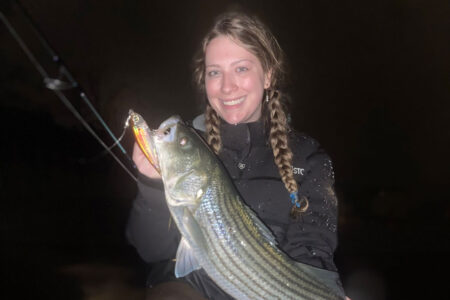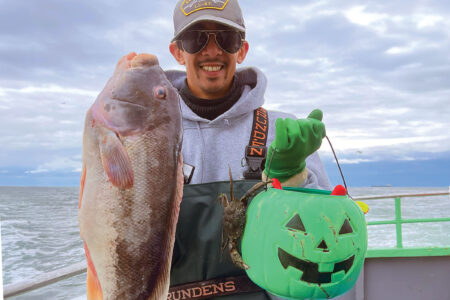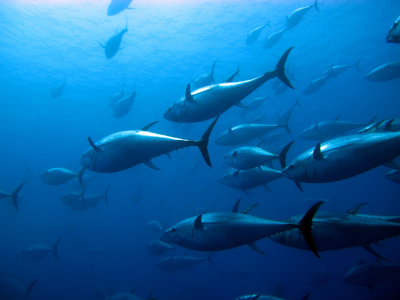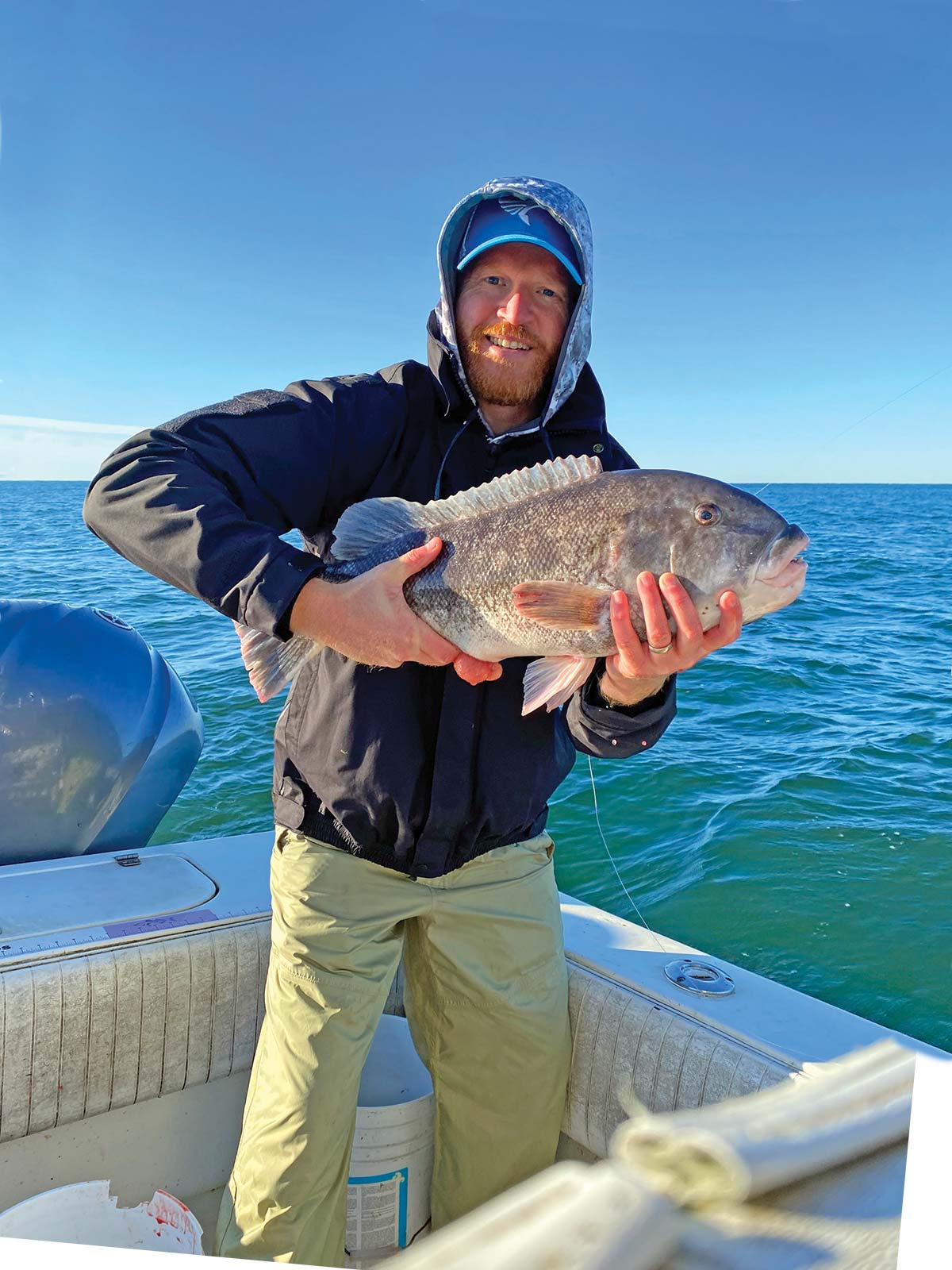
Two ways to effectively target structure–oriented fish
“Easy limits and time to fish for something else?” If you’re out fishing for a fixed amount of time, it’s good to have a target species and a plan to get them. When the fishing is great, you may catch your limit quickly or you may get a little bored with catch and release. If you’ve achieved your goal and still have a few hours to fish, now you have time to go chunking for stripers! Of course, this is easier said than done, but there is something that can increase your odds of making it happen.
One day last season, I had Dale Nicholson and Dave Anderson – sales manager and managing editor of the New England edition of The Fisherman respectively – along with Jeff Clark the local dealer rep for Minn Kota and Humminbird out for a bit of a “sportsman’s holiday.” We started on “spot 135” which is where I had caught my biggest blackfish ever. That spot is very close to shore in 30 feet of water and with the wind coming off the land it was quite flat there and easy to stay where I wanted to be with just the anchor and a short bit of scope. The current at this spot is usually quite light and this day it was not a factor but the bite was less than what I was hoping for, so after an hour or so and a few nice fish we pointed the bow south and headed out away from the land, into heavier currents and where we’d be completely exposed to the wind.
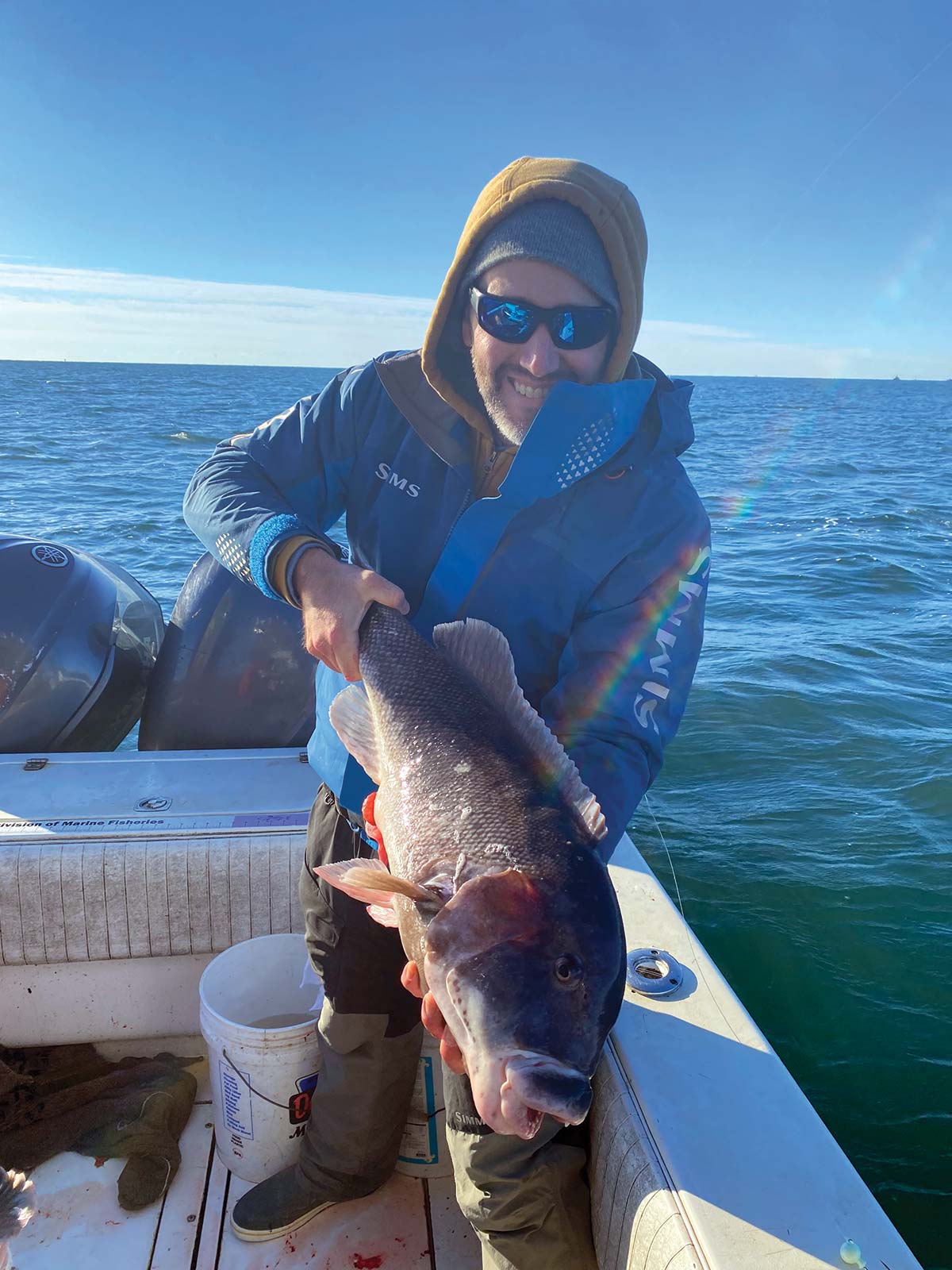
Hard Currents & Heavy Fish
“Spot 341” on my GPS (I have over 1000 spots marked), was our next stop. This little hard spot on a plateau of sand is situated in about 40 feet of water and it’s fairly featureless for a quarter mile in every direction. These rocks are situated on a little rise in the bottom and the area is no larger than my 31-foot boat. The fact that it is the only structure around makes it a magnet for any structure-oriented species that traverse the otherwise barren, sandy plateau. With the current running northeast to southwest and the wind out of the northwest at varying speeds, it was going to be very tough to anchor “just up-tide” of that structure with one anchor and I did not feel like going through all the rigamarole to double anchor.
Instead, I simply deployed my Minn Kota Terrova trolling motor with i-Pilot Link and when my boat was positioned exactly where I wanted to stay I pressed the Spot-Lock button on my networked Humminbird Solix, which is displayed as an anchor icon. With that, the GPS and the trolling motor continually “speak to each other” adjusting the speed and direction of the Minn Kota’s influence and keeping our boat perfectly positioned the whole time. Even though the current was ripping, the three batteries have enough juice to hold your position all day in most conditions!
The fishing was great; pretty much bites from big tog as fast as we could get to the bottom. On this particular day, Dale and Dave caught their personal best blackfish with Dave releasing two fish over 11 pounds. It makes my life a lot easier when I can put people on fish using technology like this.
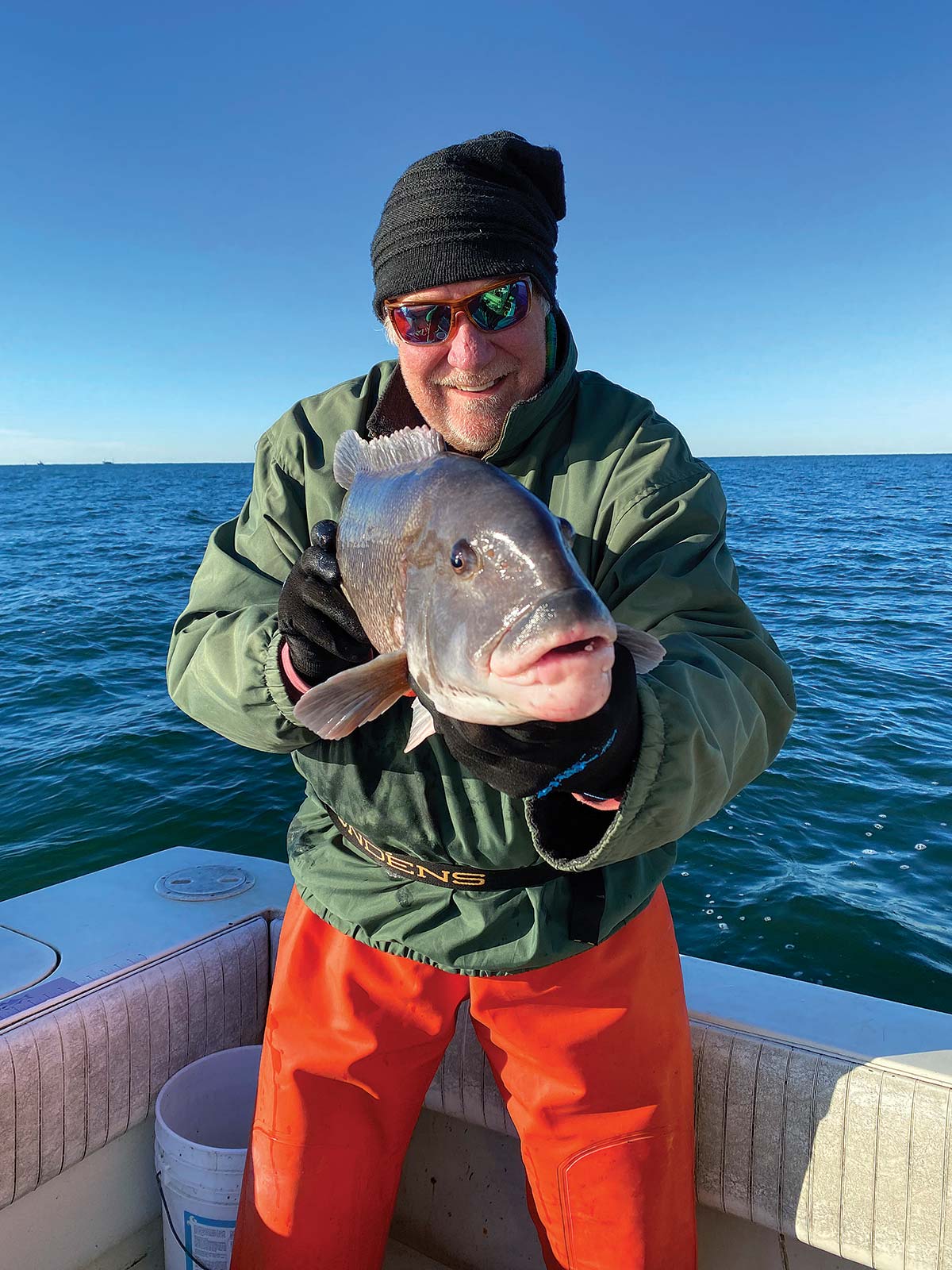
Spot Locked
Other days when it’s very windy, we also have great fishing but there is more work and time involved with positioning the boat over “easier to hit” places or going through the work of setting double anchors. On those days the fishing can be easy limits but it would be less likely that we would still have the time (I do fairly short trips) to try for limits of other species as well. The ease of anchoring quickly and accurately makes fishing a lot more efficient!
My wife, being Chinese, gives the Chinese credit for famous sayings and an example of that is: “There is a place for everything and everything in its place.” Now, I’m not sure who said that first but I am sure it is a very valid statement when it comes to getting situated over a fishing spot. There are many ways of doing things and different boats and different conditions are better suited for different methods. What does that mean to you? Before we go there, first let’s ask “why do we want to sit still right on the spot?” For one, if your fish are structure-oriented, then to fish for them most effectively you really want to be able to fish right where the fish are.
Also, most fishing structure by its very nature, tends to claim a lot of sinkers and rigs. A boat swinging wildly over different rock contours or pieces of wreckage will result in more frequent snags. However, if you stay still over one location, you will not only have far fewer snags but you will also be on the fish for more of your fishing time. These advantages cannot be overstated!
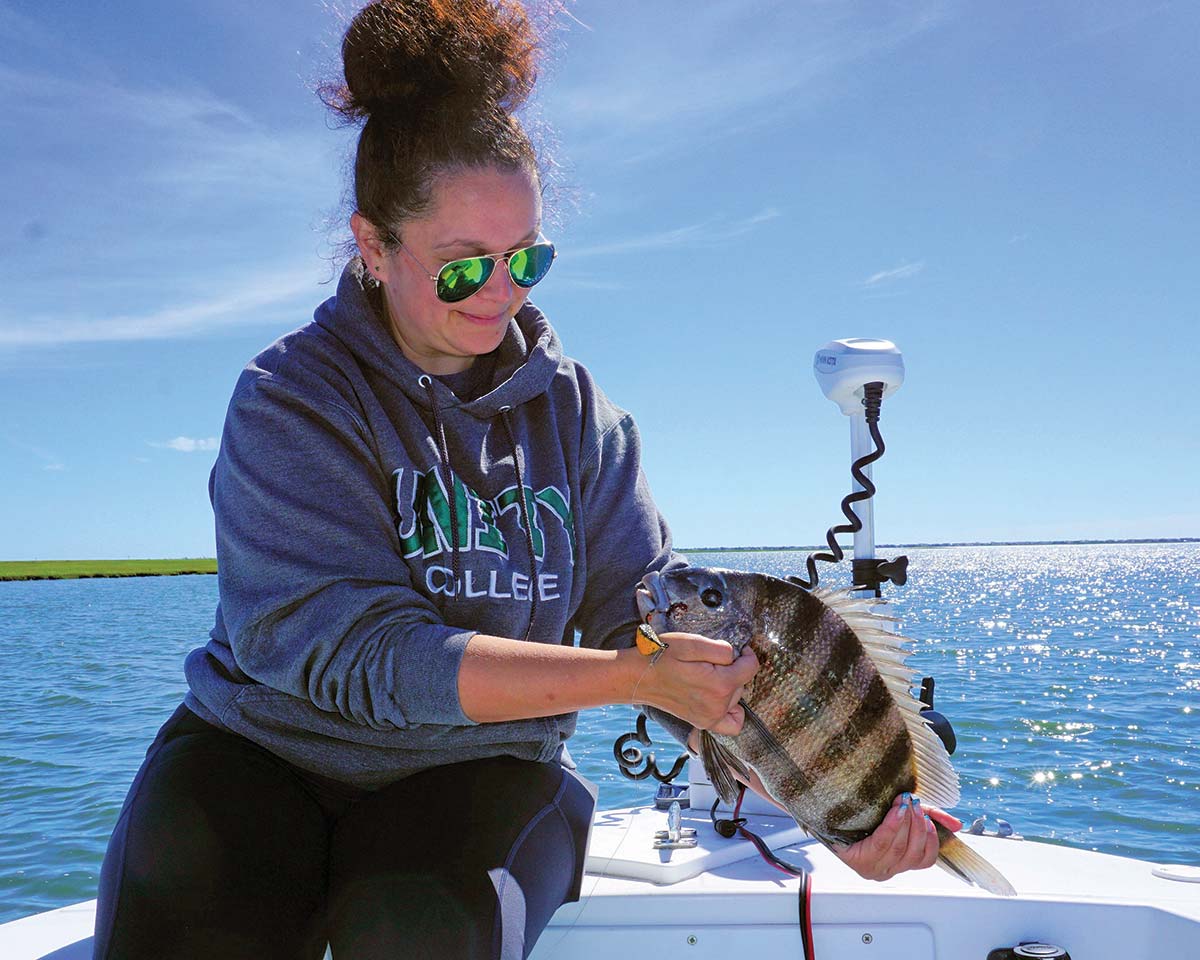
Anchors Away
So, say you’re on a 20- to 35-foot boat and your plan is go bottom fishing over “a spot”. And you want to be right on that spot without swinging all over the place; the wind is fairly light and moving in the same direction as the current. If you do not have a trolling motor interfaced with a GPS that can keep your position fixed, you can drop an anchor the appropriate distance up wind/up tide of your desired spot and all should be fine until the wind and/or tide changes.
On the other hand, say you expect the wind to be more variable, say your boat does not have a Spot Lock equipped Minn Kota trolling motor, or that the conditions will not allow you to fish your planned spots by simply dropping an anchor up-tide. What can you do? Well party boats and larger charter boats have been double anchoring for as long as I can remember. When I was a little kid my father used to take me out on party boats to go bottom fishing and I remember watching the procedure of positioning the boat and setting the two anchors.
This method of anchoring is not simple and easy, it’s usually a coordinated effort between the captain and the mate. The captain’s job is to position the boat five to seven times the depth away from and very fractionally up wind of either side of “the spot”. The mate has to drop each anchor at the captain’s command and then pay out anchor line on the first anchor until they reach the position where the second anchor will be dropped. After deploying the second anchor, the mate then has to pay line out on that one while taking line in on the first anchor. The desired result is that both anchors are set on either side of the spot with the boat in the middle. Adjustments can be made by adjusting the ropes on both anchors. When done correctly, there is very little side to side movement, with the bow portion being particularly stable.
Another variation of this same technique is to drop anchor directly upwind and then falling back twice as far as your spot to your second anchor position. Then you take up line until the boat is right where you want it and make the stern line tight. Note that very few boats do this because it can be more dangerous in several ways such as getting lines fouled in props and running gear or, if the bow anchor rips out (or if the line parts) you can end up anchored backwards to the wind/waves so this method should only be considered when you are certain of your abilities to manage it. The advantage to this method of double anchoring is that the whole boat remains fairly stable until the conditions change.
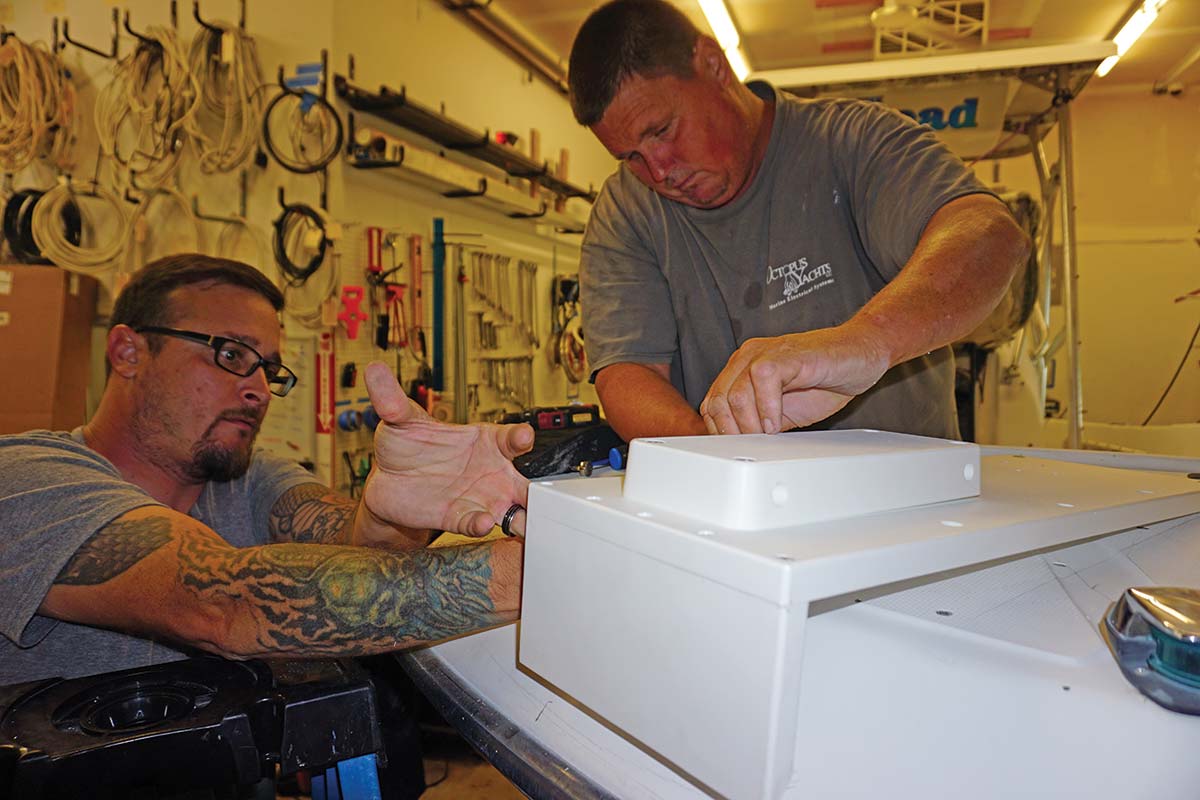
Ease & Efficiency
Now let’s say you have a trolling motor like my Minn Kota with Spot-Lock, a feature that when enabled, keeps your boat right where you designate you want it. As long as you have enough power to operate, you will be able to achieve all of that complicated double anchoring stuff without all that time and effort. Better, if your spot is not covered with fish, you can adjust your position incrementally or try many spots with just as much ease. Just keep in mind that this is a high tech, sophisticated system that involves many moving parts, and techy systems such as these come with a price. Depending on the size of your boat; the purchase of the unit, charging systems, installation, etc. can run into the “many thousands of dollars”. Is it worth it? Well, another of those famous Chinese sayings applies here: “beauty is in the eye of the beholder”.
| THE DOUBLE ANCHOR |
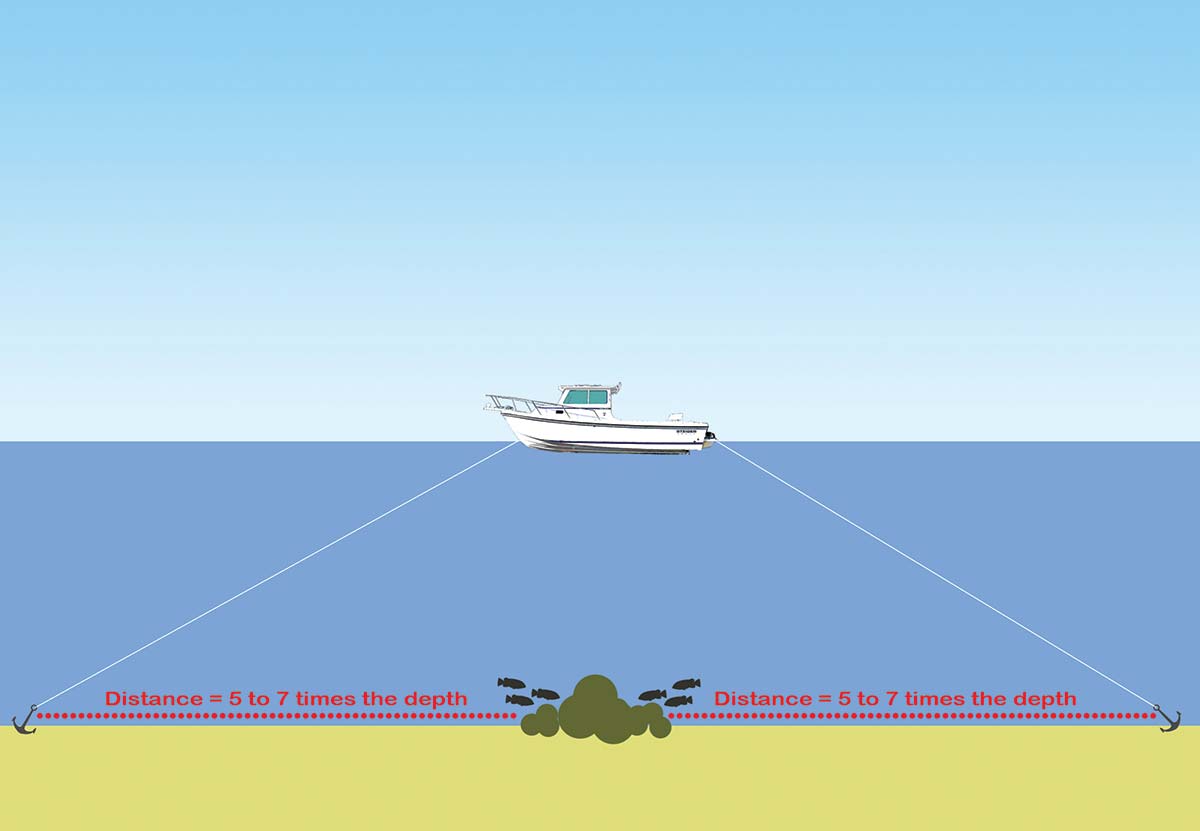
Double-anchoring is labor intensive, yet effective. After determining the drift direction, the anchor should be dropped five to seven times the depth up-drift from your target structure. The boat should then be allowed to drift that same distance past the target structure, where you’ll drop the second anchor. Final positioning is achieved by adjusting the anchor ropes until you’re right where you want to be. Diagram by Dave Anderson |
To me, the trolling motor with Spot-Lock is indispensable, just that feature alone, I believe makes it well worth the investment. For other people who do not fish at anchor so much but are “interested”, the device can be used to improve or enhance many other fishing methods. For example if you want to drift in a certain direction but the wind and/or current does not allow it, you can do it with your trolling motor! Jeff was showing me all sorts of features on the Humminbird that I could use to make the Minn Kota do many interesting things like controlling a drift so you go exactly where you want at the speed you want to go there. How about finding a particular rock in your Humminbird’s side-scan sonar, marking the GPS coordinates of that rock and then telling the motor to take you there? Is your fluke or deep jigging drift too fast? You can slow it down to just what you want—all with the trolling motor and integrated GPS!
The advantages are both amazing and widely applicable. And there is better and better technology coming out all the time. The one I have has an 87-inch shaft which keeps the prop in the water off my bow in nearly all sea conditions. In addition to the ease of use and the undeniable effect this unit has on saving time and increasing fishing efficiency, the customer service at Minn Kota and Humminbird is second to none. You can’t beat that with a stick, which I think might be another Chinese saying.
